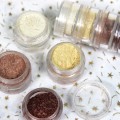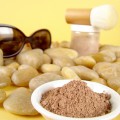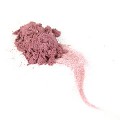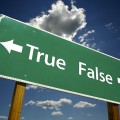 This is the final installment of our lipstick making tutorial. Post any questions you have and I will answer them in the comments section.
This is the final installment of our lipstick making tutorial. Post any questions you have and I will answer them in the comments section.
Filling these little tubes requires either a very steady arm or a set of plastic droppers. I personally use droppers but for big single color batches, you can buy a filling tray from MMS.


Check out the color variations I was able to achieve with just the colors in our Lipsafe Color Sampler pack. I added titanium dioxide to some of the colors but other than that, just relied heavily on the lipsafe micas and oxides easily available.
Ingredient Listing for your lipstick is simple – list what the product is, INCI names in descending order of use, net weight of product and who manufactured the product. The FDA has a really comprehensive web site about labeling lipsticks. You can find it here.
Quoting from their official rules (and this part is long – if you’re not interested in labeling information, just skip all the text in italics):
Who: “The name and business address appearing on the label may be those of the manufacturer, packer or distributor.
If the name and address is not that of the manufacturer, the name must be preceded by phrases such as “Manufactured for …”, “Distributed by …”, or other appropriate wording.
The name of the firm must be the corporate name, and the address may be that of the principal place of business. Stating also the name of a corporation’s particular division is optional.
The business address must include the street address, name of the city and state, and the ZIP code. The street address may be omitted if the firm is listed in a current city or telephone directory.”
Ingredient Listing: “Ingredients other than colors present at a concentration exceeding 1% in descending order or predominance, followed by ingredients other than colors present at 1% or less in any order, followed by colors present at any concentration listed in any order.”
A word on the phrase, “The safety of this product has not yet been determined.” The short answer is that all of the ingredients in your lip balm have been tested and generally recognized as safe (GRAS). According to (b) below, your lip balm and lipstick probably does not require the safety warning. To be on the safe side, you’ll want to read and interpret the rules yourself and also check with your insurance company.
Officially, the FDA has this to say about the phrase: “A cosmetic is considered misbranded if its safety has not adequately been substantiated, and it does not bear the following conspicuous statement on the PDP:
Warning – The safety of this product has not been determined.
The safety of a cosmetic may be considered adequately substantiated if experts qualified by scientific training and experience can reasonably conclude from the available toxicological and other test data, chemical composition, and other pertinent information that the product is not injurious to consumers under conditions of customary use and reasonably foreseeable conditions of misuse.
The safety of a cosmetic can adequately be substantiated by:
a. Reliance on available toxicological test data on its ingredients and on similar products, and
b. Performance of additional toxicological and other testing appropriate in the light of the existing data.
Even if the safety of each ingredient has been substantiated, there usually still is at least some toxicological testing needed with the formulated product to assure adequate safety substantiation.“
The FDA’s phone number, should you be curious about interpreting any of their information is: 1-888-463-6332. This is the main FDA Phone Number for general inquiries. They’ll pass you off to another department for specific labeling questions.

I hope you enjoyed this tutorial. If you have questions, comments or want to share your successes with lipstick making, please post in the comments section and I’ll do my best to answer.






I was looking at the FDA regs, and wondered if you knew where to look for soap? I am just starting to make my own soap,and I don’t want to mess up!!!! Peggi
Mindy – I am the messiest crafter. My poor husband – I totally decimate our kitchen on a routine basis when I craft. It’s nice to know that I’m in good company there. =)
Singing Wolf, the more liquid oils in the recipe, the thinner the consistency. The thinner the consistency, the more sheer the lipststick or gloss. So, the color will stay on the lips but also come off much easier.
To make your recipe even softer, you could decrease the wax by 10%. Or you could increase the oil by 10-15%. Start playing with your recipe in baby steps. It’s no fun to have to remelt the entire thing and start again because there wasn’t enough testing. =)
Trisha –
I’d get a round label and label the pot on the bottom. If you can’t figure out the right size of round labels, try getting a paper punch at a craft store and punching out the labels by hand. That’s not ideal but that’s an easy and cheap way to get custom labels! =)
I love the tin/pot combo!
I have a friend who prefers a “salve” like consitancy in her lip balm, stating that the one or two mini batches I’ve made in the past are too hard. My “basic” recipe is 1/3 each wax, a soft butter (like coffee or avocado butters) and liquid oil.
To adjust the firmness, would I just drop the wax/butter levels and up the liquid oils? If so, how would that effect how well the color adheres to the lips?
Hi Anne-Marie!
Thanks for the tutorial – I’ve been weeding through the FDC stuff and this has helped a ton.
Also, I’m glad to know that your workspace looks like mine when I’m done making lip balms! Mica bags and messed up pipettes all over the place.
Mindi
What is the easiest way to label a round lip butter pot? This has been a fun tutorial.